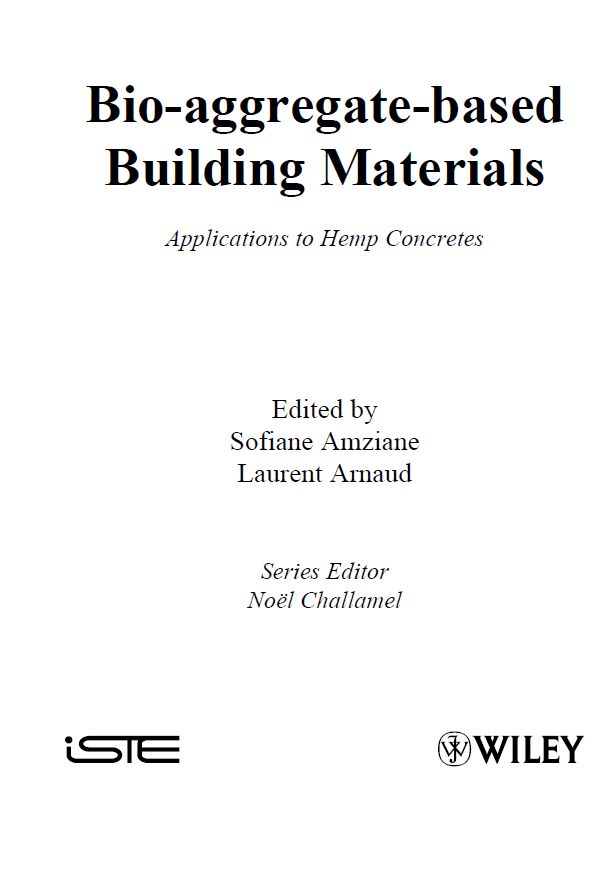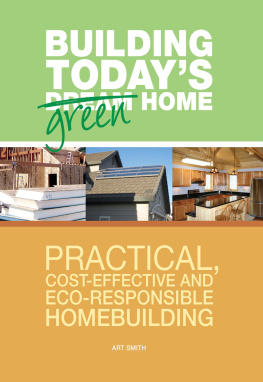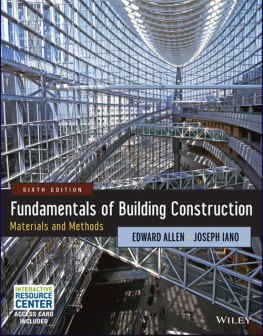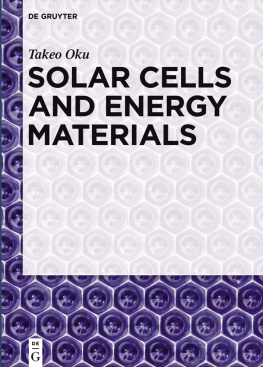Amziane Sofiane - Bio-Aggregate-Based Building Materials
Here you can read online Amziane Sofiane - Bio-Aggregate-Based Building Materials full text of the book (entire story) in english for free. Download pdf and epub, get meaning, cover and reviews about this ebook. year: 2013, publisher: John Wiley & Sons, Incorporated, genre: Romance novel. Description of the work, (preface) as well as reviews are available. Best literature library LitArk.com created for fans of good reading and offers a wide selection of genres:
Romance novel
Science fiction
Adventure
Detective
Science
History
Home and family
Prose
Art
Politics
Computer
Non-fiction
Religion
Business
Children
Humor
Choose a favorite category and find really read worthwhile books. Enjoy immersion in the world of imagination, feel the emotions of the characters or learn something new for yourself, make an fascinating discovery.
- Book:Bio-Aggregate-Based Building Materials
- Author:
- Publisher:John Wiley & Sons, Incorporated
- Genre:
- Year:2013
- Rating:5 / 5
- Favourites:Add to favourites
- Your mark:
- 100
- 1
- 2
- 3
- 4
- 5
Bio-Aggregate-Based Building Materials: summary, description and annotation
We offer to read an annotation, description, summary or preface (depends on what the author of the book "Bio-Aggregate-Based Building Materials" wrote himself). If you haven't found the necessary information about the book — write in the comments, we will try to find it.
Bio-Aggregate-Based Building Materials — read online for free the complete book (whole text) full work
Below is the text of the book, divided by pages. System saving the place of the last page read, allows you to conveniently read the book "Bio-Aggregate-Based Building Materials" online for free, without having to search again every time where you left off. Put a bookmark, and you can go to the page where you finished reading at any time.
Font size:
Interval:
Bookmark:


First published 2013 in Great Britain and the United States by ISTE Ltd and John Wiley & Sons, Inc.
Apart from any fair dealing for the purposes of research or private study, or criticism or review, as permitted under the Copyright, Designs and Patents Act 1988, this publication may only be reproduced, stored or transmitted, in any form or by any means, with the prior permission in writing of the publishers, or in the case of reprographic reproduction in accordance with the terms and licenses issued by the CLA. Enquiries concerning reproduction outside these terms should be sent to the publishers at the undermentioned address:
ISTE Ltd
27-37 St Georges Road
London SW19 4EU
UK
www.iste.co.uk
John Wiley & Sons, Inc.
111 River Street
Hoboken, NJ 07030
USA
www.wiley.com
ISTE Ltd 2013
The rights of Sofiane Amziane and Laurent Arnaud to be identified as the author of this work have been asserted by them in accordance with the Copyright, Designs and Patents Act 1988.
Library of Congress Control Number: 2012954575
British Library Cataloguing-in-Publication Data
A CIP record for this book is available from the British Library
ISBN: 978-1-84821-404-0

I am writing this foreword soon after finishing reading Sur la route du papier (On the Paper Trail) by Erik Orsenna: a wondrous journey, a lesson in history but also, and above all, a revelation about the workings of globalization. Paper is a harmless fibrous pulp originally created from old rags, and later on and to date, from wood which, filtered in the form of a thin layer, has enabled the most abstract creations of the human mind to be promulgated and become immortal. Though it has long been decried for the environmental consequences of its production, paper has now acquired a stamp of eco-friendliness thanks to the constant improvement of forestry and forest management, the manufacturing procedures and recycling. Is there any other bio-sourced material that has had a more profound impact on the development of civilization than paper? Assuredly not.
In another context, is there any other material that has made a greater contribution to the human races economic development for over a century, and to the mass development of infrastructures that that development has required, than concrete? Along with petroleum (for mobility) and silicon (for information and communication technology (ICT)), this artificial rock is one of the material foundations of our so-called developed societies. Concrete has enabled us to harness the energy from rivers, to build ports and airports, levees, sewage systems, roads, bridges, tunnels and more buildings than any other material.
Yet this material, a mixture of cement, sand and gravel which we simply call concrete, is in fact only one of the representatives of a broad category. After all, what is a concrete, if not a composite material made up of granular particles and a glue or binder holding everything together? According to that logic, bitumen concrete that of the asphalt paving that now covers our roads in an almost monopolistic fashion may be a serious challenger to cement concrete for the title of kingpin material in our infrastructures. Between them, these two materials alone constitute almost the totality of the skeleton of our lands. However, the intensive usage of these materials is not without consequences, either through greenhouse gas emissions or by the exhaustion of natural resources, be they fossil or mineral.
It might be tempting to leave the topic at that, unless for anecdotal purposes. However, there are at least two other concretes which merit our attention. The first is at least as widespread as cement and bitumen concretes on a worldwide scale; yet it is largely overlooked in our societies. Quite simply it is crude earth (not fired or baked like terracotta), which should, more correctly, be dubbed clay concrete, because it is its fine-grained constituent clay which, upon interaction with water as in the case of cement concrete, ensures the cohesion of the larger grains. In various forms compacted, molded, pasted or plastered it provides shelter to over a quarter of the worlds population. In France alone, the patrimony built of crude earth represents over a million houses. In the hands of master craftsmen and expert architects, the use of earth is fully capable of delivering on our desires for comfort and aesthetic beauty, whilst also satisfying our desire for eco-modernity.
This book is devoted to a fourth concrete, or rather a fourth family of concretes; original and promising from more than one point of view, which would seem to exhibit all the advantages of paper and earth, whilst still offering the convenience of use of our major industrial concretes. Contrary to popular opinion, sand and other granular (particulate) minerals are not an inexhaustible resource. Unless we wish to inflict irreparable damage on the environment, the time has come for recycling, or for using bio-sourced particulates, which is essentially the same thing. This is the path adopted by agro-concretes and, in particular, hemp concretes. France is the largest producer in Europe of Cannabis Sativa, whose fibers have been used to make rope for centuries. Yet this fast-growing plant, well adapted to temperate climates, harbors many other resources. Its stem, of a highly porous and therefore very lightweight wood, when ground up makes a surprising aggregate. Surprising, not on a mechanical level the only level which truly counts for mineral aggregates, with cleanliness and shape in joint second place but surprising, primarily, on a functional level: the level of hygrothermal equilibrium and acoustic properties.
Looking at the proliferation of synthetic materials available on the market, one might think that thermal, hydral and acoustic comfort is a domain in which the materials available particularly when these materials are used in combination have nearly reached the optimum desired. Polymer foams and organic and inorganic aerogels have extremely low thermal diffusivity and air permeability, which are difficult to better in the race toward very low values. Yet they lack inertia. When combined with other materials or, even better, when a solid-to-liquid phasechanging material such as paraffin or a salt is added into the mixture they (apparently) acquire the thermal inertia that they lack, by absorbing and reflecting the latent heat of fusion. In spite of their remarkable performances, these insulating materials still lack the breathability of certain natural materials, related to the capacity for absorption, transfer and phase-change of water in vapor and liquid form all properties which depend on the characteristics of the porous space of the material and the thermal and hydric coupling which manifests itself in that space.
In the face of the complexity of combinations of synthetic materials employed to ensure an acceptable degree of comfort, agro-concretes and hemp concretes in particular offer a simple solution, which draws upon the exceptional porous texture nearly always hierarchical of certain plant structures. However, in order to take advantage of this property in terms of hygrothermal exchanges, the binder used must be able to work with the granular material rather than counteracting its properties.
Font size:
Interval:
Bookmark:
Similar books «Bio-Aggregate-Based Building Materials»
Look at similar books to Bio-Aggregate-Based Building Materials. We have selected literature similar in name and meaning in the hope of providing readers with more options to find new, interesting, not yet read works.
Discussion, reviews of the book Bio-Aggregate-Based Building Materials and just readers' own opinions. Leave your comments, write what you think about the work, its meaning or the main characters. Specify what exactly you liked and what you didn't like, and why you think so.






